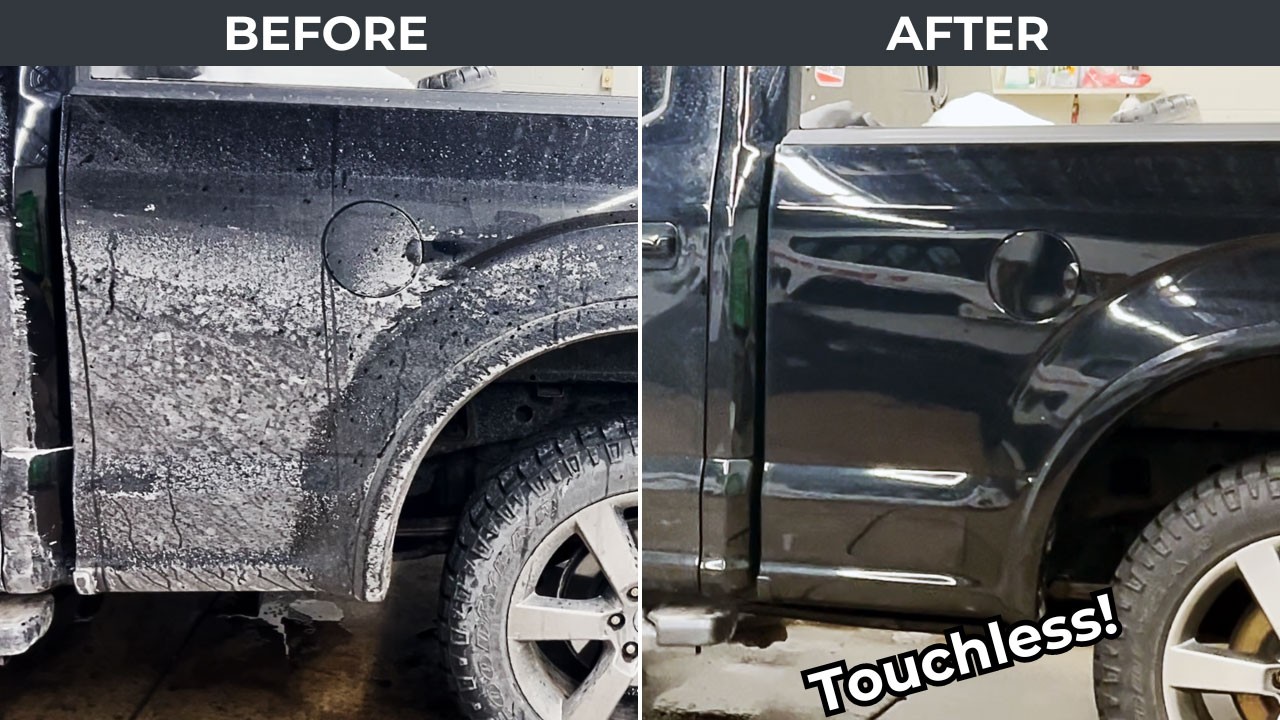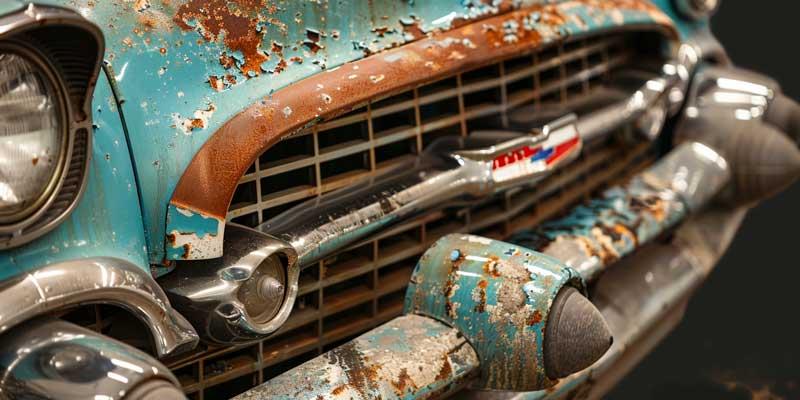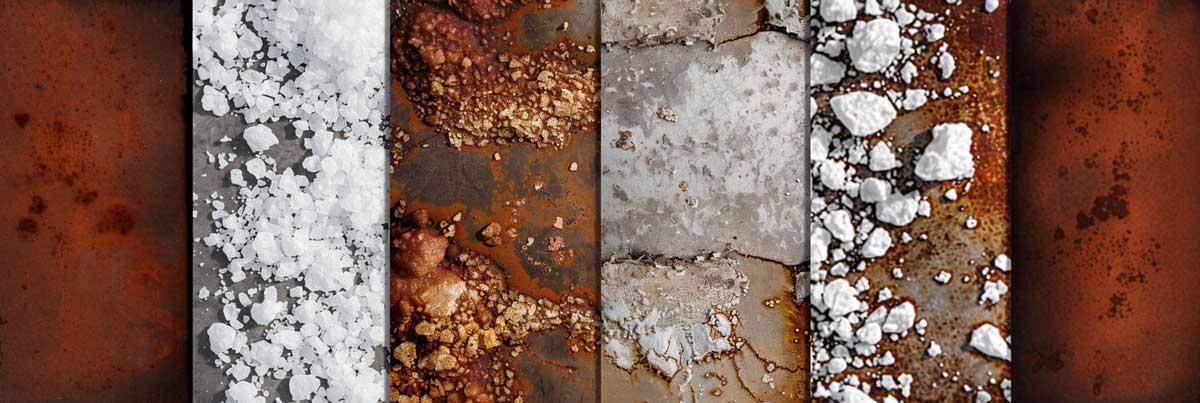FREE Shipping on Orders Over $125 in the Lower 48 States!
FREE Shipping on Orders Over $125 in the Lower 48 States!
Add description, images, menus and links to your mega menu
A column with no settings can be used as a spacer
Link to your collections, sales and even external links
Add up to five columns
Add description, images, menus and links to your mega menu
A column with no settings can be used as a spacer
Link to your collections, sales and even external links
Add up to five columns
The Best & Easiest Way To Remove Road Salt

Winter can be harsh on your vehicle with all the salt on the roads. Not only does it leave a white residue on your vehicle, but it can also lead to rust and corrosion if not properly removed.
Why Is Salt Used On Roads?
Salt is used on roadways during the winter for several reasons:
1. To Melt Snow And Ice
Salt lowers the freezing point of water.
When salt is spread on icy or snow covered roads, it causes the ice and snow to melt, even with temperatures below water's normal freezing point of 32°F (0°C).
When salt is added to water, it lowers the freezing point of the water, a phenomenon known as freezing point depression. The exact temperature to which the freezing point is lowered depends on the concentration of salt in the water.
For road de-icing, common rock salt (sodium chloride) is often used. A 10% salt solution can lower the freezing point of water to about -6° Celsius (21° Fahrenheit), while a 20% solution can lower it to about -16° Celsius (3° Fahrenheit). However, the effectiveness of salt in lowering the freezing point diminishes as temperatures drop further, and other chemicals may be used in extremely cold conditions to keep roads ice-free.

Other chemicals commonly added to the salt solution or used independently include:
Effective at lower temperatures than rock salt (sodium chloride). Calcium chloride can work in conditions as low as -29° Celsius (-20° Fahrenheit). It also has a higher capacity to attract moisture, which helps to initiate the melting process faster.
Similar to calcium chloride, magnesium chloride is effective at lower temperatures, up to -23° Celsius (-10° Fahrenheit). It is less corrosive than calcium chloride and is considered more environmentally friendly.
These are less corrosive alternatives to traditional salt but are generally less effective in cold temperatures and more expensive.
These are sometimes mixed with salt solutions to help reduce the freezing point further and minimize the environmental impact. These organic compounds can help the salt stick to the road better, reducing the amount needed.
Acetates are biodegradable and less corrosive alternatives to salt. They are effective as pre-treatment before ice forms but are more expensive than traditional salt-based methods.
These chemicals will indeed leave residues on roads, vehicles, and nearby vegetation. Like salt, these residues can be corrosive or damaging and may require removal for vehicle maintenance or to prevent environmental damage. The residues can also be tracked into homes and buildings on shoes and tires, potentially harming interior surfaces or carpets. For vehicles, it's important to wash off these residues regularly during and after the winter months to prevent corrosion and maintain the vehicle's integrity.
2. Improve Traction:
By melting ice and snow, salt also improves the traction vehicles have on the road, making driving conditions safer for motorists.
3. Cost-Effectiveness:
Compared to other de-icing agents, salt is relatively inexpensive and readily available, making it a cost-effective solution for managing icy roads on a large scale.
4. Preventative Action:
Salt can be applied to roads before a snowstorm to prevent ice from bonding to the pavement, making subsequent snow and ice removal more effective.
5. Widespread Use:
Because of its effectiveness and efficiency, salt is widely used by municipalities and road maintenance agencies across regions that experience cold, snowy winters.
Despite its benefits, the use of road salt also has drawbacks, such as potential environmental impact, corrosion of vehicles and infrastructure, and the need for careful management to minimize negative effects.
Luckily, with MAXL's MAXRemove, MAXWash, and MAXEasy, saying goodbye to winter salt has never been easier or safer. Let's dive deep into how these products revolutionize salt removal from your vehicle.
How Salt Destroys Your Vehicle
The use of road salt is a common practice to ensure roads are safe during winter.
However, the salt can accumulate on your vehicle, leading to potential rust and corrosion.
It's not just the appearance of your car at stake but its longevity and performance.

The science behind salt damage: Salt accelerates the rusting process due to the presence of water, speeding up the corrosion of metal parts on your car.
Ways salt can damage your vehicle:
Salt can accelerate the rusting process on a vehicle's metal parts. When salt is left on the car and comes into contact with moisture from the air or other sources, it creates an electrolytic reaction that speeds up oxidation on the metal. Over time, this can lead to significant rust and corrosion, especially on the undercarriage of the car, which is less protected.
Salt can also damage the paintwork of a vehicle. If there are any existing chips or scratches in the paint, salt will get into these imperfections and start the corrosion process, which can spread beneath the paint.
The exhaust system is vulnerable to salt damage, particularly in areas where the salt concentration is high due to water runoff from the body of the car. Over time, this can lead to holes and leaks in the exhaust system.
Salt can cause brake and fuel lines to corrode over time, which might result in leaks and a loss of brake or fuel line integrity.
Salt and moisture together can lead to corrosion on electrical connections, potentially leading to electrical failures and malfunctions in the vehicle's systems.
While rubber and plastic are more resistant to salt than metal, over time, salt can cause these materials to dry out, crack, and fade. This is especially true for the vehicle's undercarriage parts, which may become brittle and less effective at protecting against impacts and debris.
Different materials react to salt exposure in different ways:

Steel: The most significantly affected material; salt can cause it to rust and corrode rapidly.
Aluminum: Less prone to rust than steel but can still corrode and suffer from pitting.
Plastics and Rubber: Can become brittle and crack with prolonged exposure to salt and the freeze-thaw cycle.
Paint: Can bubble, chip, and deteriorate when salt is left uncleaned.
In all cases, it's essential to clean salt off promptly and thoroughly to minimize these types of damage. Regular washing during and after the winter months, including the undercarriage, is the best way to prevent salt from damaging your vehicle. Nothing does this better than MAXRemove!
Importance of prompt removal: To preserve your vehicle's integrity, it's crucial to remove the salt residues before they can inflict any damage.
Summary:
-
Road salt can cause rust and corrosion.
-
Removing salt promptly preserves your vehicle's integrity and appearance.
Preparing Your Arsenal with MAXL's MAXRemove, MAXWash, and MAXEasy
Before tackling the salt, it's essential to understand the power of MAXL's products.
MAXRemove uses cutting-edge AcidlessAcid technology, making it a formidable foe against stubborn salt and other contaminant stains without the harshness of traditional acids. It's safe for you, your vehicle, and the environment.
Together with MAXWash and MAXEasy, they form a dynamic trio for winter and post-winter car care.
MAXRemove's unique formula: It's designed to penetrate and dissolve salt quickly without needing a pre-rinse with water, which could dilute its effectiveness.
MAXWash removes residues, dirt, debris, grease, oil, and other undesirable substances. It also rebalances the pH of the surface.
The pH of the surface is very important for a coating to apply properly.
How MAXEasy complements the cleaning process: After removing the salt, MAXEasy provides a protective, shiny coating that repels dirt, debris, and future salt accumulation.
Summary:
-
MAXRemove dissolves salt effectively with AcidlessAcid™ technology.
-
MAXWash cleans thoroughly
-
MAXEasy offers protection and shine after cleaning.
Step-by-Step Guide to Removing Salt with MAXL Products
Start by applying MAXRemove to the entire vehicle, make sure to apply thoroughly to the heavier salted areas of your vehicle. If you do not have a foam cannon, diluting MAXRemove in the MAXL Dilution Bottle is the way to go at about 4:1 (4 parts water to 1 part MAXRemove). Add water to the MAXL Dilution Bottle first up to the line marked "4:1" then add MAXRemove to fill the rest of the way up to the black fill line on the top of the label on the bottle. Use the provided high-flow gray spray trigger and adjust the nozzle for the best coverage. Spray the entire vehicle or surface area you are wanting to remove the salt from and let it sit for at least 2 minutes to work its magic.
After allowing MAXRemove to dissolve the salt, rinse your vehicle with fresh, preferably DI water, to avoid water spots. This step ensures that all residues are washed away.
Follow up with MAXWash using the YellowCell Hypersoft Wash Sponge to safely clean without marring or scratching. This step ensures that any lingering residues, oil, dirt, or grime are effectively removed, leaving your vehicle spotless. It also ensures the proper pH of the surface which is very important for coatings to bond properly.
Thoroughly rinse off the MAXWash shampoo using DI water to avoid water spots.
Using the MAXL Drying Towel or air from a leaf blower, dry the vehicle to avoid water spots.
Summary:
-
Apply MAXRemove directly to salted areas.
-
Rinse the vehicle thoroughly with fresh DI water.
-
Use MAXWash for a deep clean, ensuring no residue remains.
-
Apply MAXEasy and/or Dry the vehicle.
Coat & Protect Your Vehicle With
The Easiest High-Performance Coating In The World
After your vehicle is clean and salt-free, applying MAXEasy ensures long-term protection.
This innovative product not only adds a shiny finish but also creates a protective barrier against future salt deposits, dirt, and debris.
It's a simple spray-on, rinse-off solution that bonds to your car's surface for lasting protection.
Work out of direct sunlight. Spray entire car using 2-4 sprays per panel, or using a foam cannon. Spray in a sweeping motion to get full coverage. MAXEasy needs to be on the surface at least 1-2 minutes to bond properly. Do NOT let the product dry on the surface. Rinse by spraying the water from bottom up to spread the product around to all surfaces before rinsing off.
To conserve product: spray on a MAXL YellowCell Hypersoft Sponge or MAXL YellowCell Hypersoft Mini and spray 1-2 sprays on the surface. Wipe in straight lines to spread the product over wide areas to ensure broad coverage. Rinse upwards starting at the bottom to help distribute the product and make contact with the entire surface. Move to next panel and repeat until all surfaces are treated.
MAXEasy's hydrophobic performance increases over a 24-48 hour period. When the vehicle is in the sun, MAXEasy will bond even stronger from the heat and performance as well as durability will increase even more.
Spray MAXEasy on to surface and spray MAXEasy into microfiber towel such as the MAXL WorkSoft Microfiber Towel, then wipe the surface to ensure even coverage. Flip the towel to a dry side and buff to a pretty finish. Be sure to always use a second dry super soft microfiber towel such as the MAXL BuffSoft Microfiber towel to do a final polishing wipe. Allow 24-48 hours for full cure to achieve maximum performance.
Summary:
-
MAXEasy adds shine and protection.
-
Easy application with lasting results against future salt and debris.
Have Confidence Every Winter With MAXL
With MAXL's MAXRemove, MAXWash, and MAXEasy, winter salt doesn't stand a chance. These products offer a safe, effective, and environmentally friendly solution to keeping your vehicle in pristine condition, regardless of what winter throws your way.
Summary:
-
MAXL products make removing winter salt safe and easy.
-
Protect your vehicle from corrosion and enhance its appearance with MAXRemove, MAXWash, and MAXEasy.
By following this comprehensive guide, you can ensure your vehicle remains salt-free and protected all year round. Embrace the winter season confidently, knowing MAXL has got your vehicle covered.